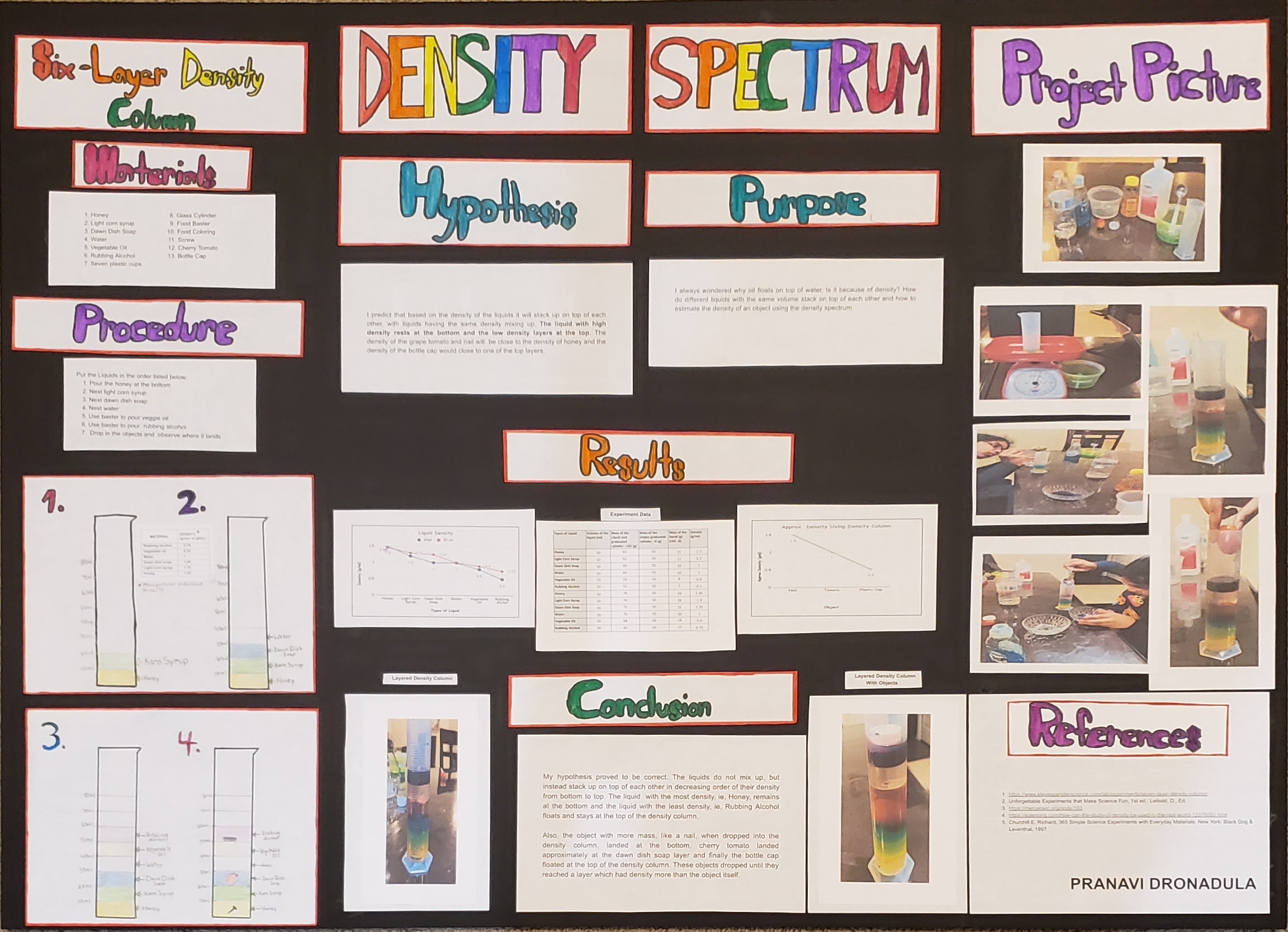Density Spectrum
Abstract:
My experiment and study was to determine the effect of density when different liquids are stacked on top of each other. I alsoestimate the density of some objects dropped gently into the density column based on the layer where it lands. The big question I had was when the liquids are stacked on top of each other, they do not mix, instead they layer neatly on top of each other. In this project, I analyze how this happens and data to support the analysis. Result of the experiments was that the liquids stack on top of each other and do not mix up. Theobject (nail) with more mass dropped landed at the bottom, cherry tomato landed approximately at the dawn dish soap layer and finally the bottle cap floated at the top of the density column. To conclude, the different liquids stacked because of their density. The liquid with heaviest density sank to the bottom, and layered up in the decreasingorder from bottom to top. The objects dropped until they reached a layer which had more density than the object itself.Bibliography/Citations:
No additional citationsAdditional Project Information
Research Plan:
Purpose: I always wondered why does oil float on top of water. Is it because of density? How does different liquids with the same volume stack on top of each other and how to estimate the density of an object using the density spectrum.
Hypothesis: I predict that based on the density of the liquids it will stack up on top of each other, with liquids having same density mixing up. The liquid with high density rests at the bottom the low density layers at the top. The density of the grape tomato and nail will be close to density of honey and the density of the bottle cap would close to one of the top layers.
Procedure:
- Weigh measuring cylinder and each liquid individually to determine the density of each liquid.
- Pour 10ml of each liquid in order below into the measuring cylinder
- Pour the honey first
- Next light corn syrup
- Next dawn dish soap
- Next water
- Use baster to pour vegetable oil
- Use baster to pur rubbing alcohol
- Observe how the liquids layer up in the cylinder
- Drop in object one by one and observe where it lands in the density column.
Data/Analysis:
- As density defined as relationship between mass of the substance to its volume, I measured the 10 ml liquid mass of each liquid by using a scale. Using this data, I continued to experiment by stacking the liquids in the order of their density high to low. This helped me to analyze that the liquid density measure is an important measure why the different liquids with the same mass stack instead of mixing up. To document the finding, I prepared a graph to show the density scale of the liquids used in my experiment.
- Determine the approximate density of the object dropped based on the density of the liquid layer where the object lands. The object travels through the liquid column until it reaches a layer which is more dense than itself. Represent the approximate density of the object on the graph.
References:
- https://www.stevespanglerscience.com/lab/experiments/seven-layer-density-column/
- Unforgettable Experiments that Make Science Fun, 1st ed.; Leibold, D., Ed.
- https://mercersec.org/node/163
- https://sciencing.com/how-can-the-study-of-density-be-used-in-the-real-world-12076093.html
- Churchill.E. Richard, 365 Simple Science Experiments with Everyday Materials. New York: Black Dog & Leventhal, 1997/
Safety:
• Always have an adult with you to help you during your experiment.
• Rubbing alcohol is flammable, so it must be kept away from any open flames or heat.
• Conduct this experiment in a well-ventilated area

